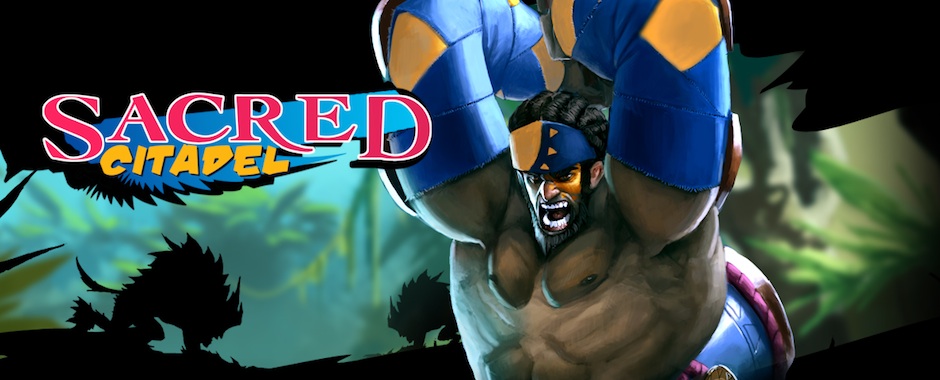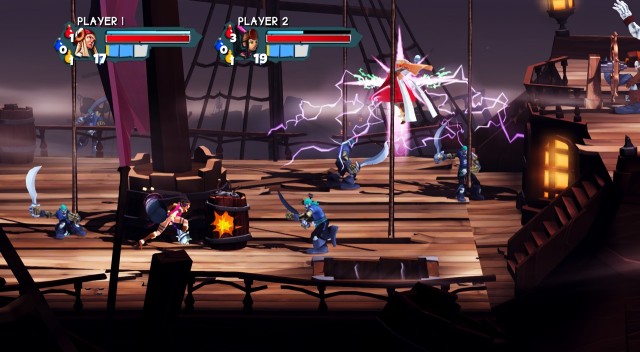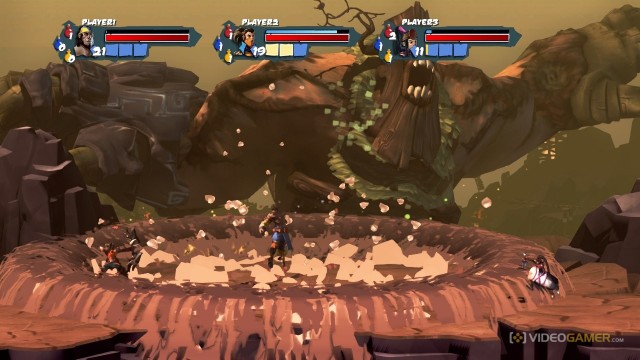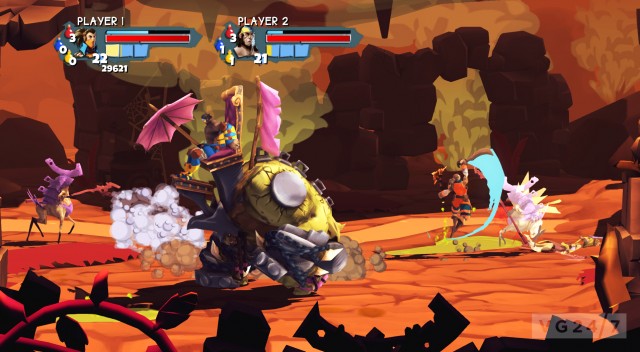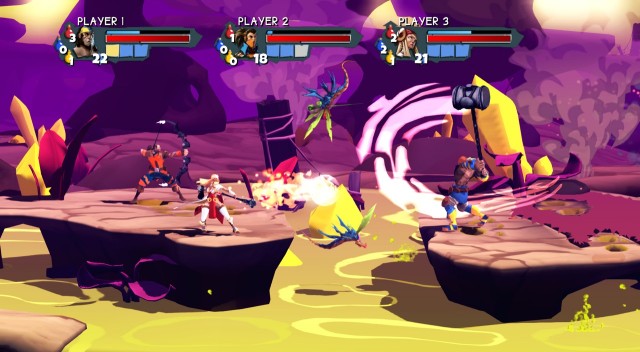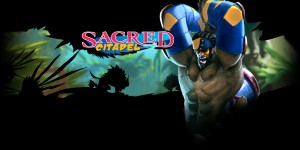 The history of the Sacred franchise’s business dealings is almost as long and intricate as the lore behind the mystical continent of Ancaria itself. If you’re unfamiliar with this European game franchise, its mainline entries consist of loot-driven action RPG’s, not unlike Diablo or Borderlands. These games were originally developed by former German studio, Ascaron, who have since gone bankrupt, leaving the series’ creative rights in the hands of rising German publisher, Deep Silver. Before Ascaron’s bankruptcy, Deep Silver published the second game in the series, Sacred 2: Fallen Angel, which released in 2008 to mixed feedback on PC, Xbox 360 and PS3. Its uneven feedback and extended development cycle were largely blamed for Ascaron going under. The original and better-received first game, simply known as Sacred, never released on consoles and was launched exclusive to the PC in 2004, published in this case by a different publisher entirely, a company called Encore. It was also something of a hidden gem, since the PC gaming market was going through a decline at the time. Nonetheless, Sacred has discovered new life as a beloved title on Steam, where it’s bundled with its expansions, so PC gaming RPG fans should definitely give it a shot if they haven’t already.
The history of the Sacred franchise’s business dealings is almost as long and intricate as the lore behind the mystical continent of Ancaria itself. If you’re unfamiliar with this European game franchise, its mainline entries consist of loot-driven action RPG’s, not unlike Diablo or Borderlands. These games were originally developed by former German studio, Ascaron, who have since gone bankrupt, leaving the series’ creative rights in the hands of rising German publisher, Deep Silver. Before Ascaron’s bankruptcy, Deep Silver published the second game in the series, Sacred 2: Fallen Angel, which released in 2008 to mixed feedback on PC, Xbox 360 and PS3. Its uneven feedback and extended development cycle were largely blamed for Ascaron going under. The original and better-received first game, simply known as Sacred, never released on consoles and was launched exclusive to the PC in 2004, published in this case by a different publisher entirely, a company called Encore. It was also something of a hidden gem, since the PC gaming market was going through a decline at the time. Nonetheless, Sacred has discovered new life as a beloved title on Steam, where it’s bundled with its expansions, so PC gaming RPG fans should definitely give it a shot if they haven’t already.
What this mess of corporate juggling means is, the planned Sacred 3 has stalled several times in the changing of hands and re-allocating of resources, and is now being threatened by the looming release of next-gen consoles, perhaps delaying it even further. Deep Silver remains committed to the game however, and they’ve decided to re-affirm that commitment to fans by releasing a digital download prequel to the stalled Sacred 3, that being Sacred Citadel.
Developed by Swedish studio, Southend Interactive, Sacred Citadel is an arcade-style beat ‘em up game with RPG elements. It appears to take quite a bit of inspiration from Sega’s arcade classic, Golden Axe, and even moreso from Capcom’s lesser-known Dungeons & Dragons arcade games, soon to be bundled and re-released on current consoles’ digital platforms. Of course, the fusion between beat ‘em up and RPG mechanics was a lot more novel back in the 90’s, since, following the release of X-Men Legends, Marvel: Ultimate Alliance, Castle Crashers, Scott Pilgrim vs. The World: The Game and others, this blend of genres has been done quite a few times since, especially recently on digital console channels. This leaves Sacred Citadel sort of lost in the shuffle, since, while there’s nothing technically ‘bad’ about the game, there’s nothing great or noteworthy about it either.
Upon starting a game session, you have a choice between four playable characters; The unnamed Warrior, Ranger, Mage or Shaman. Each character begins at level 1, gaining EXP and leveling up as they fight their way through hordes of enemies across the game’s four Acts, each comprised of five stages, and each has specializations geared towards certain play styles. Many of these are predictable. The Warrior is strong and durable, but also slower than the other characters. The Ranger is quick and nimble, specializing in physical projectile attacks, but having lesser durability. The Mage has weaker physical capabilities, being about keeping her distance and using offensive elemental spells from afar. Lastly, the Shaman is most suited to co-op play, using buffs and curses that boost allies and stymie enemies respectively, even if she also manages to be a surprisingly speedy and able fighter in a pinch, as well as if you‘re just playing solo.
The differences between each character come into play with both their Secondary Attacks and Power Attacks. You have a basic attack button that lets you string together some quick hits with any character, all of whom are able to dual wield the same three weapons in any combination; Swords that are more likely to score critical hits, Axes that can’t be blocked, and Maces that have a chance to stun enemies. You can also incorporate Secondary Attacks to end your combo with a specialized blow. Oftentimes, these Secondary Attacks are used for crowd control, with the Warrior using his strength to knock enemies away and give himself some breathing room, while the Mage can detonate a magic burst into enemies’ faces, temporarily stunning them. As you gain levels, new Secondary Attacks and combos become available to you, expanding your arsenal of attacks, and giving you plenty of ways to defend yourself against foes. You’ll also gain new tiers of Power Attacks, which are built up as you do damage to enemies. When unleashed, you’ll use a devastating attack that affects all on-screen enemies, or, in the case of the Shaman, provides a buff for your party.
On paper, the combat mechanics in Sacred Citadel are quite flexible and well-conceived. The problem comes in the fact that fighting with any degree of finesse is often unnecessary, only occasionally demanded when trying to hunt for Achievements/Trophies that demand more careful play. Enemies are often dumb as toast, mostly just charging at you or standing still and swinging their weapon around at thin air, leaving them wide open to being dodged and countered. They’ll often just walk right into environmental traps as well, sometimes allowing you to just sit back and let a crusher or spiked log kill your foes for you. A handful of enemies will block your attacks later in the game, but they can’t block Axes, nor can they block Secondary Attacks, which will send them flying and hitting the ground hard, allowing you to run up and keep pounding them into the dirt by mashing the attack button mindlessly before they can stand up. In fact, it’s so incredibly easy to stun-lock your enemies in Sacred Citadel, that it removes almost any degree of challenge from the combat, even when playing solo! Consequently, just about every enemy, even the tiny enemies, will send even the hulking Warrior flying through the air like a rag doll with a single hit, forcing you to constantly wait for your character to keep falling down, then getting back up; Lather, rinse, repeat. Bottom line, the combat in Sacred Citadel is pretty brainless at best, and really ho-hum at worst, even for beat ‘em up standards. Most of the game is just doing a three-hit regular attack, followed by a Secondary Attack. That same combo is your chief method of disposal, seeing you through even the main boss fights without any thought required. It gets monotonous pretty quickly.
To be fair though, the main bosses at the end of each Act are actually pretty well-designed. They’re more powerful, require more thought and strategy to defeat, and, even if they’re still rather easy, like Sacred Citadel as a whole, they’re at least fun to fight against, especially with a group of players. Before the culminating battle against these bigger baddies, you’ll face minibosses in just about every stage beforehand, but they’re more disappointing, often just being larger and more annoying versions of the regular enemies. The enemy variety is already a bit miniscule in Sacred Citadel to boot, even if effort is made to introduce a unique new foe in each Act. Still, you’ll be facing the same Grimmocs, Miners and Beasts all throughout most of the game, which only makes the already one-note combat even more bland. Occasionally, you’ll get to mix things up not just with traps, but also with Mounts, giant beasts that you can ride and use to deal heavy damage to groups of foes at once (the most obvious nod to Golden Axe), as well as hostile terrain like falling rocks or runaway mine carts. It ultimately doesn’t do enough to make fighting the same paltry groups of foes interesting though.
Sacred Citadel attempts to take advantage of the loot-driven focus of its mainline RPG inspirations to at least try and add replayability to the game, but again, the shallow gameplay limits the appeal. You can find and equip gradually more powerful sets of weapons and armour as you play, allowing you to boost your character’s offensive and defensive capabilities, which can be purchased and swapped around in towns as well. Towns can be entered from the stage menu by pressing a separate button, not only allowing you to buy and toggle equipment for your character(s), but also letting you purchase items like beneficial Potions and Crystals, which help to give temporary boosts in battle. You can also take challenges from the Bookkeeper to see if you can beat levels while attaining a certain score, satisfying a certain time limit, or never dying. This is largely unnecessary however, unless you care about completionism, since you’ll always have more than enough money to see you through the game, simply by beating down enemies as they come.
You may assume that the combat can at least be more entertaining if you bring a group of friends along, and this assumption would be correct, however slightly. You can play co-operatively either locally or online as well, which is great! The only problem with the co-op is that it’s limited to three players. Yes, three players! This is absolutely baffling on current platforms, with both the Xbox 360 and PS3 effortlessly accommodating up to four simultaneous controllers, let alone the system link you could set up when playing on PC. It seems extremely arbitrary, and there’s no conceivable reason for it. Making this worse is the fact that the game has four playable characters, yet limits co-op to three players. Why?! This design decision makes absolutely no sense! It could be another throwback to Golden Axe, which supported three players in the arcades, but that was a game released in 1989, where three players was a novel thing! In 2013, on current-gen consoles and PC’s, it’s just a needless limitation that drags down the game’s appeal in comparison to competing four-player beat ‘em up games that are available on the same platforms, for the same price. You’d better have established gaming friends to bring too, should you not want to go the adventure alone. During every Quick Match attempt we made, the online servers were completely barren. No one is playing Sacred Citadel online it seems, and frankly, it’s not difficult to fathom why, since there’s so many better competing options.
If anything is going to be an outright piss-off to people in Sacred Citadel however it’s the Day-One DLC. The game’s fifth Act, ‘Jungle Hunt’, is locked out in the main game download, forcing players to fork over an extra $5 for it if they want to play the last chunk of the story. This is perhaps the most obvious indication that Sacred Citadel was rushed, since five Acts were clearly planned, with the fifth likely not being ready before the game had to be released. In that case though, why wasn’t it free to download?
The reason why gamers hate Day-One DLC is because they’re effectively being punished for a publisher trying to make a deadline, cutting content that should have launched with the game as a result, then subsequently trying to profit from their own impatience and greed. We shouldn’t have to pay for that! As if that weren’t bad enough, the fifth Act is one of the best in the game too, and ties up a loose end left hanging after you defeat Sacred Citadel’s final boss. It also comes with a few more Achievements/Trophies to scoop up, extending the play value a bit further. Really though, Sacred Citadel is already having trouble justifying itself beyond the starved, die-hard Sacred fans, who are already going to be wary about the changes to the gameplay and genre in this offering. Having Day-One DLC that forces you to pay extra for the end of the story is only going to make Sacred Citadel look like an even more unattractive investment to would-be players!
If you’re curious about any potential differences between the three available versions of Sacred Citadel, there are a couple of note. The game is largely the exact same experience on any of its platforms, but it’s also clear that, unlike its mainline predecessors, Sacred Citadel was definitely designed with consoles in mind. As such, the Steam version isn’t quite as well-optimized for PC play, having surprisingly large system requirements, even for a smaller digital download game with merely modest visual fidelity, and not being all that comfortable or intuitive to play with a keyboard. The game only supports one unimpressive type of modest resolution as well, not giving you any kind of real flexibility with the system settings. The mere existence of the Steam version is kind of a mystery, since beat ’em up games don’t feel all that much at home on a PC, and it likely only exists because of the Sacred series’ heritage and emphasis on the PC platform. Even so, the Steam version is the least recommendable of the three.
For the most part, the only difference between the Xbox Live Arcade and PlayStation Store releases of Sacred Citadel is which controller you use. Upon further examination however, it’s not difficult to deduce that the game was mainly developed with Xbox Live Arcade as its flagship platform. Not only are the controls a little more ergonomically sound on an Xbox 360 controller versus a PS3 controller, but a more blatant drawback in the PS3 build is that it’s missing some Trophies. Some Achievements recorded on Xbox 360 and PC are not acknowledged as Trophies on PS3, with half of the expected roster of Trophies that players should be able to earn, which should be matching the Achievements of the Steam and Xbox Live Arcade releases completely, inexplicably missing.
This is another hint that Sacred Citadel may have been rushed, since it’s clear that the PlayStation Store version was put together after the other two, and the developers don’t seem to have had time to implement all of the Trophies that were supposed to be in the game. Obviously, the Xbox Live Arcade edition mandates a mandatory 400 Gamerscore worth of Achievements to be approved for release, and the Steam version’s own Achievement roster is identical to the Xbox Live Arcade roster’s, even if its resolution and system settings were left out, likely due to the same time constraints. On PS3 however, Trophy requirements are much less strict, and games can effectively have as many or as few Trophies as they want, with a maximum cap, but a much less-defined minimum roster. It’s pretty easy to infer that the PS3 build of Sacred Citadel had to lose Trophies to make a simultaneous release with the other two, since it wouldn’t have been denied release on the PlayStation Store for lacking a certain degree of Trophies, whereas the game would have been rejected for Xbox Live Arcade release if it was missing the necessary Achievements. Oh, and it probably goes without saying, but there’s no Platinum Trophy. We can’t say we’re surprised.
In this case, it’s pretty evident that the Xbox Live Arcade edition of Sacred Citadel is the most complete and recommendable of the three, since the Steam and PlayStation Store editions are noticeably compromised in some respects. Again, the gameplay and progression is exactly the same on all three platforms, with all of the same co-op and online functionality. Still, since the Steam and PlayStation Store releases are clearly missing features, it’s obvious that Sacred Citadel was mainly designed with Xbox Live Arcade in mind, making the game at its most well-realized on Xbox 360, even if just by a tad.
In fact, on Xbox Live Arcade especially, the worst you can say about Sacred Citadel is that it’s just so aggressively generic, even with some decent ideas in its concept. Yes, the Day-One DLC that denies players the final chapter of the story if they don’t pay an extra $5 is an undeniably negative element to the package. On top of that, if you’re a PC and/or PS3 gamer that doesn’t own an Xbox 360, you’re going to be annoyed at what your preferred platform was denied in porting. Beyond that however, everything about Sacred Citadel is technically fine, just not in any way noteworthy. The graphics are fine. The sound is fine. The gameplay is predictable, but fine. The features you would expect to be here are here for the most part, even if the three-player cap is pointless and irritating. As a beat ’em up, this game does enough to make par.
That’s precisely why Sacred Citadel is an underwhelming disappointment, even if it’s not a bad game. Xbox Live Arcade and the PlayStation Store especially are absolutely packed with beat ’em up games like this one, many of which are more ambitious, many of which are more memorable, and many of which are more original. Even when Sacred Citadel attempts to win players over with some humourous dialogue, you’ll just feel like other competing beat ’em ups on the same platforms have done their own humourous dialogue so much better. When you’ve already played through games like Castle Crashers, Scott Pilgrim vs. The World: The Game and Double Dragon Neon, Sacred Citadel just fails to stand apart.
On platforms that are already loaded with the same kind of game, failing to stand apart is not a good thing. There’s just no reason to download and play Sacred Citadel, when you can just as easily use that time and money on a better and more noteworthy game of the same variety. Even Sacred fans who are waiting with bated breath for Sacred 3, will be very disappointed at the lacklustre and trite quality of Sacred Citadel’s painfully shallow and hackneyed storyline, which does absolutely nothing to tease tantalizing potential plot developments for Sacred 3. We can appreciate Sacred Citadel as a gesture of good faith that Sacred 3 is still planned for release at some point, but that’s all it can be appreciated as. If you’re curious, playing a demo will likely show you all that you need to see, especially if you don’t have friends willing to tag along. If you’ve already played the many superior beat ’em ups available on the same platforms, and just want another way to effectively crack skulls, we would also feel more inclined to advise you save your online funnybucks for the impending release of the Dungeons & Dragons arcade bundle. That will give you two superior games for the same price, and they’ll even come with further expanded RPG elements, if you’re especially attracted to that too.
As it stands, Sacred Citadel just feels like an attempt at a time-wasting distraction to weakly try and ease the wait for Sacred 3. It’s a stopgap game that will be quickly forgotten, and you have many better options.

